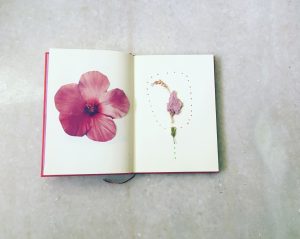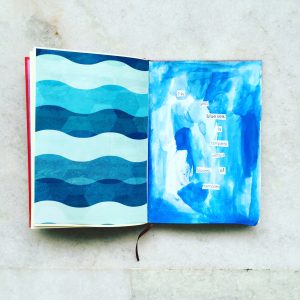How Collaging and Scrapbooking Helps Me Write Better
 I first began collaging soon after I turned thirteen; I still have sketchbooks from those years, page after page filled with collage narratives that I had abstracted from paper pieces ripped from magazines and newspapers. These sketchbooks also contained my tentative forays into water-color painting: a fuchsia bougainvillea blooming beneath a cerulean blue sky, a Rajasthani puppet hung from a door handle. When I now leaf through those sketchbooks, I realise it has taken me a very long time to return to pursuing something which has of late greatly impacted and facilitated my writing.
I first began collaging soon after I turned thirteen; I still have sketchbooks from those years, page after page filled with collage narratives that I had abstracted from paper pieces ripped from magazines and newspapers. These sketchbooks also contained my tentative forays into water-color painting: a fuchsia bougainvillea blooming beneath a cerulean blue sky, a Rajasthani puppet hung from a door handle. When I now leaf through those sketchbooks, I realise it has taken me a very long time to return to pursuing something which has of late greatly impacted and facilitated my writing.
I have always perceived collaging as a jigsaw puzzle; as I tear out and put together the pieces of paper into a discernible visual narrative, I am also shepherding the scattered thoughts in my head and assembling them into some sort of an organized pattern. My collages are as much a story of colors, shapes and textures as they are windows into my mindscape.
A few months ago, as I often struggled with the blank computer screen syndrome, ideas unwilling to migrate from mind to screen, I decided to develop an alternative writing routine; it was my equivalent of warming up my writing muscles, easing the transition from bald reality into a writer’s parallel universe.
Having embarked upon writing morning (or very often, afternoon!) pages, an idea that I religiously began implementing from Julia Cameron’s iconic ‘The Artist’s Way’, I often afterwards indulged in a bit of art-making: it could be painting a fallen peepal tree leaf that I found in my neighborhood or combining a found fallen flower, watercolor, and collaging into a visual art piece.
Over the time, as I observed my inclination towards and the sheer joy I derived from pursuing the latter, I decided to give my collages a home in an A-5 sized sketchbook and placing them inside there. It not only made for a beautiful book to browse through but also gave a glimpse into my current moods and inclinations, accurately pinning down the otherwise transient clouds of ideas and inspiration upon paper.
 One of my entries in this scrapbook/sketchbook was a collage poem I created about the sea; the process of locating and cutting out the words, putting them together into a poem, and complementing it with watercolors and collage made me more sensitive to the art of composition than had I been doing the same either in a journal or on the computer.
One of my entries in this scrapbook/sketchbook was a collage poem I created about the sea; the process of locating and cutting out the words, putting them together into a poem, and complementing it with watercolors and collage made me more sensitive to the art of composition than had I been doing the same either in a journal or on the computer.
It was as if I was literally crafting the poem, becoming an artisan of sorts, transforming the text into a tangible object that could be read in multiple ways. The process of collaging and watercolor involving in creating the poem made me much more immersed in it, making me more palpably aware of the words that I was fishing out from the word sea in a magazine and placing them on paper to create an alternative ocean of words.
I also picked up a DIY poetry-art technique from Pinterest which involved blacking out a certain passage in a book and revealing only selected words; you were creating poetry from an existing text and coloring in to creative expanses of negative and positive space. It was both a visual and creative writing exercise, closely examining and reinterpreting the text while also playing around with the blocks of solid color that dominated the page.
I paired fallen hibiscus flowers and watercolor dots with a cut out paper hibiscus from a fashion magazine, experimenting with the texture contrasts and realities to create something which I would enjoy looking at as well as reminding me of a time where I saw flamboyant hibiscus flowers wherever I went.
What happened after I regularly began creating these collages was that when I sat down to write, all the images and colors and associations flying around in my head had been given a home. I wouldn’t even say that those ideas had been previously caged because that would have meant imprisonment; rather, what I wished to do was to provide an alternative and appropriate home to those specific ideas which could not find expression in writing. Having satisfactorily corralled them up, I could now smoothly progress to channeling other ideas into my writing without being distracted.
I have now in my possession two books of my thoughts; one is the notebook in which I write daily missives to myself, documenting my observations, thoughts, and ramblings. The other is my collage/scrapbook/sketchbook, which too are notes to myself except that they are entirely visual in nature. Re-presenting thoughts in an alternative fashion, they enable me to ‘work’ things out much in the way a walk often enables you time and space to meditate upon and figure out aspects which are blocking and troubling you in a piece of writing.
—
Priyanka Sacheti is a writer based in New Delhi, India. Educated at Universities of Warwick and Oxford, United Kingdom, Priyanka previously lived in Sultanate of Oman and United States. She has been published in numerous publications with a special focus on art, gender, diaspora, and identity. She’s author of three poetry volumes and two of her short stories have been published in international anthologies featuring Indian immigrant writing.She’s currently working on a collection of short stories. An avid amateur photographer, she explores the intersection of her writing and photography at her blog, http://iamjustavisualperson.
Category: Contemporary Women Writers, How To and Tips
























